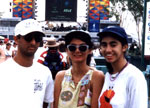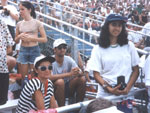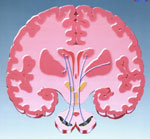

|
|
How do you handle this? By Bijan Farzan
The torch was brought into the dark stadium and passed to the next person, who carried it toward it's destination. The suspense was building, yet it was unclear who would ultimately light the final flame. Suddenly the whole stadium went silent-a silence that lasted only a fraction of a second before erupting into a big roar. What was happening? What did the crowd of 100,000 see that caused a collective gasp for breath? On the stand, waiting to receive the torch was none other than Mohammad Ali: the Champ, the Greatest. For the past two decades he had been out of the public eye due to a health condition. Now he was back standing tall, but with one noticeable difference. His hand was visibly shaking. Was it possible that the Champ was nervous? As he turned toward the Olympic flame, his shaking unexpectedly stopped and he reached out and lit the flame. By this time, the TV broadcaster managed to contain his enthusiasm and started to talk about Ali and Parkinson's disease. Muhammad Ali is one of an estimated 1.5 million people in the United States affected by Parkinson's disease. Although the disease most commonly strikes older people, about 10% of Parkinson's cases are under the age of 50.
Parkinson's disease, or PD for short, is a neurological disease that causes movement disorder. While the causes of PD are still unknown, its effects are well-documented. Basically, all body movements are controlled by a complex feedback system of nerves to the brain. To communicate, nerves use neurotransmitters such as dopamine. In people with PD, production of dopamine is for some unknown reason reduced. As a result, the feedback system does not work, as it should. This leads to the most common symptom of PD: tremors in the hands or legs while they are resting, or supposed to be resting. Therefore, if you concentrate you can stop it, as Ali did while lighting the Olympic flame.
To begin, there is no positive test to establish PD. Diagnosis is done primarily by process of elimination. Doctors check for all kinds of other reasons first, ranging from a brain tumor to simple Copper deficiency. Then they check for other symptoms of PD like stiffness of muscles or slowness of bodily movement. As a result, close to 10% of cases are misdiagnosed. Of course there is one sure way to find out-- dissect the brain and look at the area responsible for producing dopamine, which in patients with PD is reduced in size or barely visible. The problem with this method is that doctors do not know how to put the brain back together! Since PD is a progressively degenerative disease, by the time you notice the first symptoms you have had the disease for several years. Therefore, it is easier to check for other signs.
After I mentioned it to my wife, she said that she recently had noticed my walk had changed, but could not single out how until now. Another sign of slowness shows itself while I am typing. Since my left hand including my fingers is slowed down, my right hand finishes typing before my left hand has a chance to start. For example, if I want to type "Piccolos" I would end up with "piolccos" or "pioloccs" or something like that. More visible consequences of PD are changes in facial expression and difficulty in speaking or swallowing. Equipped with this information, I diagnosed myself with PD and headed to my doctor, with my head full of information and my heart hoping I was wrong. More neurological tests eventually confirmed my PD. What next? I already knew that there was no cure for Parkinson's-- only a control of the symptoms and a hope to slow down the progress of disease. James Parkinson first diagnosed this disease in 1817. Since then the medical community has discovered more than a dozen drugs and several procedures, but none of them the cure. Each drug has its own effects and worse, side effects. Therefore, under the supervision of my doctor I have started experimenting with different medications and dosages. I started with Sinemet, a brand name for Levodopa, which is the first drug developed for PD and the most commonly prescribed for Parkinson's. Levadopa is converted to dopamine to refurbish the depleted supply in the brain. Today there are a dozen or so newer drugs that boost the effect of Levodopa or mimic dopamine directly. After 5 years, I am still experimenting to find the right cocktail just for me. The brain is really a big chemical factory. It uses all kinds of hormones, neurotransmitters and other chemicals to perform its functions. Generally, the body does not like any of these chemicals. Therefore, most medications targeted for the brain cause serious side effects, the most common of which are dizziness, nausea and occasional hallucinations. Each time I start a new medication or change my dosage, I have to go through several days of dizziness and nausea until my body gets used to it. The problem is that in some people, the body adapts and tolerates the drugs and after a few years they lose their effect, and it becomes time to move on to a new drug. There is no natural occurrence of PD in the animal kingdom except for us humans. Lack of animal models for experimentation results in slow progress in discovering new drugs and procedures to cure Parkinson's. In 1982, a team of Silicon Valley doctors, while working with drug addicts discovered a method to introduce Parkinson's-like symptoms in animals. Their research resulted in a new way to study and fight this disease and evolved into a new research center. The Parkinson's Institute in Sunnyvale is now one of the leading PD research centers in the United States. So what does the future of Parkinson's research look like? Promising and encouraging! This year at least five different new drugs have emerged from laboratories and entered into the first phase of human trial. Thus far at least one of them shows the potential of slowing down or even reversing Parkinson's symptoms. News from the surgical front however is mixed. For a while, brain surgery was a hot topic in finding a cure for PD. But so far the two most talked about methods-- removing a small and selective part of the brain or putting in a simulating probe--have not produced the wide-scale and permanent results they originally promised. So I am not ready to cut a hole in my brain yet! The most promising treatment with the best potential of reversing the progress of PD is now coming from stem cell research. If introduced into the right section of the brain, stem cells supposedly can be converted to dopamine-producing cells and cure the patient.
The recent entertainment news that Michael J. Fox was diagnosed with Parkinson's disease brought a lot of attention and some extra research money to this field. The list of famous people with PD is long and diverse -- Mohammad Ali, Janet Reno, Michael J. Fox, the Pope, (and me!) are just a sample. In almost every family there is a chance that you can find at least one person that either has been diagnosed or has PD symptoms. Everyday we are getting closer to a cure for this disease, but we are not there yet. I feel confident that a cure for Parkinson's will be found. Whether or not it happens in time to help me remains to be seen. In the meantime, what should I do? How does one handle a degenerative, progressive disease while waiting for a cure to come? I have learned to cope with the disease and its symptoms by changing my attitude. However, coming to terms with the illness was not an easy process at first. The first step for me was learning to control my anger and avoid falling into the downward spiral of depression. I combated it by changing my lifestyle, by staying active, and by exercising. I use my condition to my advantage: I dance to cover my tremor or I sing in the shower to keep my vocal cords from becoming stiff (and the best part of it is nobody dares to complain about my awful voice!). I have accepted my condition as my new way of life. I have realized that no matter how much it affects me, like Ali, I too can stand tall and light a new fire...

|
|
Web design by Bcubed
Internet server Global Publishing Group
































 The big mystery that night was who would be the last
person to carry the Olympic torch and light up the Olympic flame. I can still remember
it as vividly as when it happened. We were sitting at home watching the opening ceremony
for the 1996 Olympics in Atlanta.
The big mystery that night was who would be the last
person to carry the Olympic torch and light up the Olympic flame. I can still remember
it as vividly as when it happened. We were sitting at home watching the opening ceremony
for the 1996 Olympics in Atlanta. The next day, we stopped
at a roadside diner outside of Birmingham, Alabama. We were on our way to watch the
Olympic games and had decided to fly to Alabama in hopes of avoiding the crowds and
chaos of the Atlanta airport. While waiting for our first southern meal, I admitted
that I had no knowledge about Parkinson's disease. My son, who at that time was a
human biology undergraduate at Stanford University, gave us a short lecture.
The next day, we stopped
at a roadside diner outside of Birmingham, Alabama. We were on our way to watch the
Olympic games and had decided to fly to Alabama in hopes of avoiding the crowds and
chaos of the Atlanta airport. While waiting for our first southern meal, I admitted
that I had no knowledge about Parkinson's disease. My son, who at that time was a
human biology undergraduate at Stanford University, gave us a short lecture. At that moment, I thought
to myself that recently my left leg had been shaking (as if I was trying to tap it
to music), especially while doing a recurring movement like typing. I had no trouble
stopping it, but no control on starting it either. Was it possible that I have PD?
No way, I said to myself. I am only 45 years old --too young to get PD. But what
about Ali? He learned he had Parkinson's when he was 42. To be sure, I did what every
good engineer would do: I surfed the net and hit the books. What I learned was fascinating.
At that moment, I thought
to myself that recently my left leg had been shaking (as if I was trying to tap it
to music), especially while doing a recurring movement like typing. I had no trouble
stopping it, but no control on starting it either. Was it possible that I have PD?
No way, I said to myself. I am only 45 years old --too young to get PD. But what
about Ali? He learned he had Parkinson's when he was 42. To be sure, I did what every
good engineer would do: I surfed the net and hit the books. What I learned was fascinating. Generally, PD starts from
one side of the body with symptoms like tremor, rigidity, slow movement, and difficulty
with balance and walking. So far, we have established that I have tremors in my left
leg. Slowness in my left side also affects my walking; one obvious sign is that I
do not move my left hand, making my walk kind of funny. Try it yourself, walk normally
with both hands swinging front to back. Now stop your left hand only -- you will
find you walk like a cowboy holding his hands over his six-shooter ready to draw!
Generally, PD starts from
one side of the body with symptoms like tremor, rigidity, slow movement, and difficulty
with balance and walking. So far, we have established that I have tremors in my left
leg. Slowness in my left side also affects my walking; one obvious sign is that I
do not move my left hand, making my walk kind of funny. Try it yourself, walk normally
with both hands swinging front to back. Now stop your left hand only -- you will
find you walk like a cowboy holding his hands over his six-shooter ready to draw! It is certainly an exciting
time for PD research. Finding a cure now seems attainable in my lifetime. Obviously
the biggest obstacle in finding a cure is money. Government funding is limited and
has too many strings attached. A lack of general knowledge about this disease has
produced limited private funds.
It is certainly an exciting
time for PD research. Finding a cure now seems attainable in my lifetime. Obviously
the biggest obstacle in finding a cure is money. Government funding is limited and
has too many strings attached. A lack of general knowledge about this disease has
produced limited private funds.
